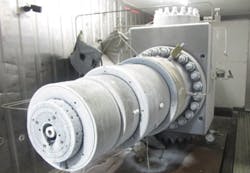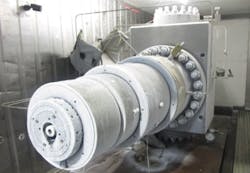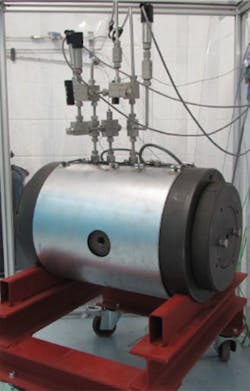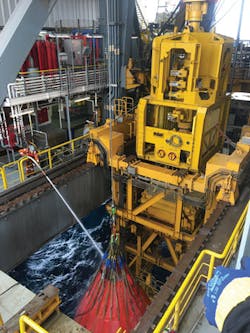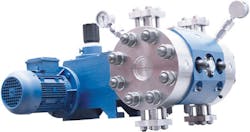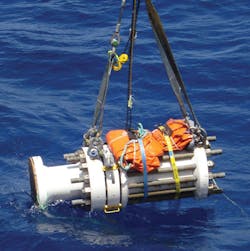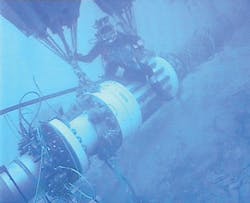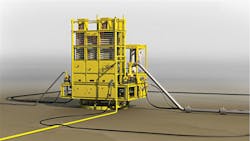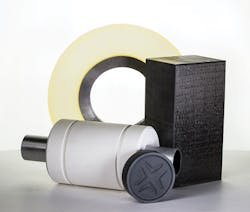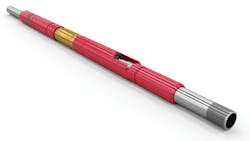New tools and technology for the offshore industry
Multi-function gate valve provides improved shear, seal capabilities
Michael O’Sullivan
Enovate Systems
Well barrier philosophy is a critical component of all aspects of life cycle well integrity management. During workover of a live subsea well the intervention system typically includes an emergency disconnect package and either a lower riser package (LRP) or well control package (WCP). The safety barriers are located in the LRP/WCP. Industry standards require two well barriers during all well activities where a pressure differential exists that may cause uncontrolled outflow from the wellbore to the external environment [1]. These barriers typically comprise a safety head (SH) and production isolation valve (PIV).
Enovate Systems has developed En-Tegrity, a 73⁄8-in., 10,000-psi (689-bar) shear and seal gate valve (SSV) with dual independent barriers for use as a SH, PIV, and/or combined SH and PIV. The SSV has been qualified as a SH and is currently undergoing qualification as a PIV. The use of a single valve as a SH/PIV facilitates a reduction in the number of valves in the LRP with consequent savings in weight and stack height.
There are six key innovations that differentiate this technology from conventional gate valves, namely:
- A reverse actuation method. To close the valve the gates are pulled across the bore rather than pushed into it. This means that the hydraulic pressure is aligned with the bore pressure resulting in the latter assisting closure and allowing the SSV to close on a flowing well. Wellbore pressure assists closure.
- Superior shearing.The actuator system can deliver 1 million lbf and is designed to shear all envisaged work strings and tubing likely to pass through the wellhead during intervention operations at lower pressures than conventional gate/ram valves. During qualification testing En-Tegrity cut 3.5-in. S135 drill pipe at pressures of around 1,500 psi (103 bar) and 27⁄8-in. 90ksi coil tubing at 500 psi (34.5 bar). In deepwater applications the lower cutting pressures required more efficient use of accumulation because of the improved useable volume available.
- Improved sealing. Full metal-to-metal sealing provides better sealing capability than conventional gate valves through having separate shearing and sealing surfaces means that during shearing operations the sealing portion of the gate remains clear of the shear area, minimizing the risk of damage to this surface.
- Bi-directional sealing. When closed, upper and lower seal plates align with upper and lower seats providing bi-directional sealing.
- Dual independent barriers from below.The system is operated by two independent hydraulic actuators. Well isolation is achieved even with only the upper gate functioning.
- Reduced maintenance.Conventional gate valves require frequent maintenance to replace elastomer seals due to damage caused by erosion and degradation from temperature exposure and corrosive chemicals. As the SSV does not have any elastomers in the bore, maintenance intervals can be extended.
Over the last two years Enovate has performed a program to qualify the En-Tegrity SSV as a SH, in accordance with the following standards:
- API 6A (ISO 10423), Annex F, PR2 for a temperature range of -18°C to +121°C (-0.4 to 250°F) [2]
- API 6A (ISO 10423), Annex I, Class II Flow Testing
- API 17D (ISO 13628-4), Annex L, Hyperbaric Testing to 3,000 m (9,842 ft) [3]
- Norsok D-002, Annex B Cutting. [4]
Further planned developments of the technology include extending the qualification of the 73⁄8-in. SSV as a PIV and development of an 18¾-in. preventer for use in place of a blind shear ram/casing shear ram in BOPs. New requirements in the recently published BSEE Final Well Control Rule for BOPs mean that existing BOP rams will have difficulty demonstrating their ability to cut all pipe used during well completion and drilling operations. However, the shear and seal capability of the En-Tegrity system is not impacted by the new rule.
References
[1] NORSOK Standard D-010, Rev 3, August 2004
[2] API 6A, Specification for Wellhead and Christmas Tree Equipment, 19th Ed, July 2004
[3] API 17D, Specification for Subsea wellhead and tree equipment, 2nd Ed, September 2011.
[4] Norsok D-002, Well Intervention Equipment, Revision1, 2000 and Revision 2, June 2013
The author
Michael O’Sullivan is Technology & Development Director at Enovate Systems. He has 25 years of experience in the subsea industry and is an acknowledged authority on riser system technology. He has worked on many joint industry initiatives to develop subsea technology and enhance system reliability. He led the JIPs that developed the current API standards for unbonded flexible pipe (API Spec 17J and API RP 17B) and flexible pipe ancillary equipment (API Spec 17L1 and API RP 17L2). He holds bachelor’s degrees in Mechanical Engineering and Law, and a Master’s degree in Aeronautics & Astronautics from MIT.
Wild Well Control successfully combines new, existing technology on GoM P&A job
Wild Well Control recently combined its well intervention solution with a riserless internal-cementing tool to P&A a well in 7,000 ft (2,134 m) of water in the Gulf of Mexico. Using this new strategy, the company has successfully P&A’d six more in record time, so far completing seven of nine wells since the campaign began earlier this year.
In a press conference at May’s Offshore Technology Conference, Martial Burguieres, Wild Well vice president of Marine Well Services, said: “The new tools and techniques used on this project have already exceeded expectations.”
The system combines two technologies: the 7Series intervention system in conjunction with its new Wild Well DeepRange cementing tool. The riserless subsea P&A tool is an alternative to traditional method operations “that can save customers millions of dollars,” commented Burguieres. “Around 50% is shaved off of current market rates,” he observed.
New cementing tech
The DeepRange cementing tool is certified to depths of up to 10,000 ft (3,048 m) and a maximum working pressure of 10,000 psi (690 bar). It employs a binary plug comprising resin and cement, developed along with CSI Technologies, to increase the likelihood of a successful test as well as the overall long-term effectiveness of the plug. The operation takes place from a multi-service vessel (MSV) that contains about 1,000 sq m (10,764 sq ft) of back deck, a moonpool, working-class remotely operated vehicles, and a heave-compensated knuckle boom crane with 60 tons (54 metric tons) capacity at depth.
Although this is the company’s second P&A campaign, with the first being deployed in Angola, it is Wild Well’s first in deepwater. The main difference between the two is that the engineers had to place a minimum 200-ft (61-m) cement barrier into the outer annuli in deeper water.
After the company used the 7Series circulating lines and pressure control valves to deal with annular casing pressure, divers used the hot tapping equipment to penetrate into the production bore from outside the wellhead. But in the new campaign, hot tapping would not work. The idea was to be able to keep all operations under constant pressure control and eliminate the need for diver intervention.
While current P&A methods could range between $40 and 60 million per well, Wild Well Control claims that it has found a way to reduce those costs significantly. The DeepRange operation occurs from a MSV, which costs less than a mobile offshore drilling unit. Burguieres stated that while totals can vary slightly, given the total amount of work and configuration of the well and production system, huge cost savings are occurring. The company’s target was $12 million per well, and on this recent campaign, he said that the price exceeded the goal by a very small amount.
“This new technology is a game changer, and is going to be the future of P&A practices,” he added.
P&A process
Wild Well Control crews temporarily abandon the well, then cut and pull the tubing before installing a cast-iron bridge plug in the production casing on electric wireline. The upper abandonment - consisting of an isolation bushing, tubing-conveyed perforating guns, and a seal assembly - are landed and latched into the 7Series and packer.
Perforation charges are deployed on e-line and are used to perforate the tubing into the B annulus, just above the top of the cement. Circulation is established through the tubing, into the lower perforations, up the B annulus, out through the upper perforations, and back up the production annulus. The isolation bushing diverts flow to the return lines, commented Burguieres.
The binary plug is circulated into the B annulus. After waiting on the cement to harden, a mandatory pressure test is performed on the tubing and annulus of the plug, in accordance with US Bureau of Safety and Environmental Enforcement regulations.
Circulation is then established through the C annulus by firing the previously set, tubing-conveyed upper perforation guns and e-line conveyed lower guns. The perforating gun is then run on e-line, below the lower packer and detonated, creating holes through the production and surface casing into the C annulus. Circulation is again established through the C annulus as with the B annulus before.
The binary plug is circulated into the C annulus and is left in a “balanced” condition with the production annulus. After waiting on the cement, another test is performed. The volume of resin displaced into the cement will be dictated by the competency of the cement plug. A plug is set in a profile below the packer, which turns into an additional mechanical barrier. The P&A retrieving tool is run on the crane wire and the P&A tool assembly is released and recovered to the surface.
The upper abandonment assembly is unlatched from the packer and pulled from the well. The cast-iron bridge plug is set above the highest perforations and cement is bailed. The well is then fully P&A’d to satisfy annular isolation regulations, he said.
On the most recent well completed, Wild Well successfully performed the operation on the B, C, and D annuli.
New metering pump reduces topsides footprint, weight
Offshore operations are fraught with many daunting challenges - from harsh environmental conditions to high opex. Space limitations are one of the most common challenges, as operators must fit heavy-duty drilling and production equipment onto a rig’s topsides. Plus, depending on whether it is a jackup, semisubmersible or a drillship, topsides availability can be a major obstacle. As a result, equipment size and weight are key considerations for offshore installations.
The NOVADOS metering pump with a double acting double diaphragm head developed by Bran+Luebbe, an SPX FLOW brand, helps offshore operators meet those challenges. It reduces the footprint, size, weight, and cost compared to other available hydraulic diaphragm and plunger pumps. The high precision metering pump delivers the same capacity as an equivalent duplex pump, while decreasing topsides footprint and weight by 20% - saving much-needed, critical space on offshore rigs.
SPX FLOW’s NOVADOS metering pump has a sturdy gearbox that is designed for continuous duty, improving reliability and minimizing the risk of downtime during critical operations. The gear set is splash-lubricated, no external oil pump or tubing is needed, reducing the need for extra accessories on offshore rigs. Operators have the flexibility to adjust the pump’s capacity via stroke length - manual, electric, or pneumatic are all fully interchangeable with each other - or speed via a variable speed drive.
The new metering pump offers flexibility for operators working in the unpredictable and constantly-changing offshore environment. All gear sizes in the NOVADOS series can be combined with a variety of diaphragm or plunger head designs to achieve the required flow rate and pressure parameters. The metering pumps can accommodate single or multi-stream applications and are available in horizontal or vertical configurations.
Hydratight upgrades subsea pipeline offshore Western Australia
Hydratight has completed an upgrade project on the John Brookes subsea pipeline on the North West Shelf of Western Australia.
Contracted by Quadrant Energy Pty Ltd. on behalf of the John Brookes joint venture, Hydratight engineered, manufactured, delivered, and supported the installation of an 18-in. MORGRIP connector on the subsea pipeline located 54 km (34 mi) northeast of Quadrant’s Varanus Island facilities.
Hydratight engineers Mark Fisher and Bob Till were embedded in the offshore installation team.
“This was an exciting project to be part of due to strict safety and environmental expectations in place,” explained Fisher. “These included working closely with a DNV inspector who flew in from Singapore to witness all aspects of the upgrade. It also meant an independent critique of our manufacturing procedures.
“The component parts were of extremely high specifications and we had strict rules on forging and manufacturing. These included the use of a compliant biodegradable mineral hydraulic fluid used for activating the tensioners and flushing and cleansing all tooling. We ensured no other unassessed hydraulic fluid was used.”
A representative from Quadrant Energy oversaw the factory acceptance test of the completed connector in the UK, before witnessing a second test and diver training on arrival in Australia.
Fisher added: “We were pleased to be able to provide face-to-face technical support to Quadrant prior to and during this challenging international project.”
Bespoke features were included on the engineered product including corrosion resistant alloy cladding, composite graphite seals, the company’s ball and taper technology and its subsea tensioning equipment.
The company says the MORGRIP series of connectors is known for a leak-free record since they were first installed in the 1980s as an alternative to welding. They take less manpower and fewer man hours during commissioned projects. The technology is a permanent solution, yet the connector can be detached and reused.
GE Oil & Gas launches new subsea connector
GE Oil & Gas has completed the qualification of its upgraded 36kV high-voltage wet mate connector.
The company said that MECON WM 36/500 is designed to offer more reliability and predictability in subsea power system connections, and can be used with equipment such as transformers, switchgears, variable speed drives, and motor loads. It also noted that by improving the reliability of subsea power transmission and distribution, MECON WM 36/500 supports the ambitions of oil and gas operators to develop cost-efficient subsea production and processing facilities.
Alisdair McDonald, subsea power and processing leader, GE Oil & Gas, said: “Unlike conventional stab-type connectors, we deploy a unique connection process that ensures that we are in full control of the electrical environment inside the connector before completing the electrical connection.”
GE uses the same patented technology for all of its MECON wet mate connectors. An in situ flushing process enables the verification of a benign electrical environment, it explained. The flushing process is performed after the connector halves are brought together and before the electrical connections are completed.
Firstly, the connector is flushed with seawater to remove any contaminants, then by fresh water, then alcohol, and finally dielectric fluid. The dielectric fluid is analyzed to verify a benign electrical environment before the electrical and mechanical connection is completed. The process is enabled by a closed-loop flushing tool mounted on a conventional ROV and takes less than 20 minutes in total to complete and no fluids are released to the environment.
In addition, GE said MECON WM 36/500 can act as an isolation switch at rated system voltage and can be used to verify system health prior to commissioning or to find faults after failure.
MECON 36/500 has undergone more than a year of testing to comply with industry standards, the company added.
The connector has been certified for operation up to 36 kV and 500 amperes in water depths down to 10,000 ft (3,000 m).
Saipem, Total collaborate on subsea water treatment technology
Saipem has entered into an agreement with partners Total and Veolia for the co-ownership and exclusive commercialization of SPRINGS subsea water treatment technology.
An alternative to topsides water treatment and injection units, SPRINGS, which stands for subsea process and injection gear for seawater, is a nanofiltration-based sulphate removal unit designed for use in deepwater environments.
Saipem said one of its main advantages is that it allows for greater flexibility in the water injection pattern in order to better sweep the reservoir. In addition, SPRINGS can lead to savings on topsides weight and deck space through the removal of the subsea water injection network.
The three companies collaborated on the technology, and a deep sea test was successfully completed in 2015 offshore West Africa. Development began in 2007.
By moving the sulphate removal process subsea, Saipem said the technology enhances the economics of oil recovery by:
- Eliminating water injection sealines
- Freeing up deck space for production equipment and reducing topsides weight producing savings in terms of weight and deck space
- Easing brownfield retrofits by, particularly on FPSOs
- Making satellite, deep injection wells economical.
Materia introduces new thermoset resin line
Materia Inc. has launched its Proxima resin portfolio, developing a range of products that it says can provide “reliable, practical, and economical solutions” to challenges in subsea thermal insulation, subsea buoyancy, and downhole tools.
The resins are easy to process due to their low viscosity and controlled cure profile, explained the California-based company, adding that the resulting products are ideal for use in extreme environments.
“Compared with commonly used polymers, Proxima thermosets withstand the most extreme hot/wet conditions and provide excellent performance,” Materia said.
The technology line’s HTI resins for high-temperature subsea thermal insulation provide a thermal barrier between high-temperature flowlines and seawater, enabling production of reservoirs with oil temperatures up to 400°F (204°C) without resorting to pipe-in-pipe or subsea cooling systems.
In addition, the line’s polymers maintain structural integrity in operating environments at water depths greater than 10,000 ft (3,048 m). The company said this insulation technology can be applied in the factory or the field.
Brian Conley, senior Proxima product development manager, said, “Materia’s subsea thermal insulation products offer full system integrity for high-temperature deepwater environments. The use of Proxima HTI polymers results in lower risk and better reliability for insulation of high temperature subsea flowlines, field joints, and equipment relative to the alternative engineered solutions.”
Proxima STR thermosets are designed for use in syntactic foams in subsea buoyancy applications. These lightweight materials withstand the severe hydrostatic pressures of deepwater and ultra-deepwater environments while providing substantially improved buoyant support to critical subsea components.
Daryl Allen, Proxima product development manager, said, “Proxima HPR casting resins offer thermal stability and toughness with fast and easy polycrystalline diamond compact or tricone drillability for many downhole applications. When long fiber composite performance is required, Proxima ACR infusion resins offer exceptional performance with fiberglass and carbon fiber.
“These bring improved thermal stability, corrosion resistance and reliability when compared to standard composite materials. Both the HPR and ACR systems provide superior materials that solve today’s downhole challenges.”
Materia supports its customers with application engineering services provided from its prototyping and polymer testing facility in Pasadena, California.
Weatherford introduces deepwater integrated completion technologies
Weatherford has developed a new portfolio ofintegrated completions technologies specifically for deepwater wells. These solutions have been engineered and tested beyond API 14A standards to provide reliability in the most challenging environments.
WFX0 gravel pack system
The first fully integrated, V0-rated gravel-pack system, the WFX0 system combines the gravel-pack string with a deep-set barrier. Incorporating an ISO/V0-rated WFX0 packer, WFX0 quick connect, and WFX0 gravel-pack sliding sleeve, and designed to run with the TerraForm packer, shunt-tube screens, and the OptiBarrier ball valve, the new system eliminates the need for a dedicated deep-set barrier run with an additional packer and ball valve. By enabling single-trip gravel packing across multiple zones, the gravel pack system has the potential to save two to three days of rig time.
Optimax series safety valves
The Optimax series itself is not new; 7,000 valves have been deployed with 20,000 years of cumulative service life and zero failures attributed to the design. Recently, the series has expanded with the addition of super-slim valves and deep-set valves. Compared to curved-flapper safety valves of an equivalent size, Optimax super-slim flappers have a reduced outside diameter for use in smaller casing strings. The new deep-set valves are designed to provide fail-safe closure at depths greater than 12,000 ft (3,658 m) without being affected by tubing pressure or relying on the long-term storage of nitrogen.
Annular safety valve system
One example of how Weatherford applies RFID technology to downhole completion tools is the annular safety valve (ASV) system. The system incorporates three field-proven technologies-the high-pressure-rated OptiPkr+ production packer, the Optimax series ASV, and the RFID-enabled hydraulic communication sub-to help prevent unplanned gas releases during gas-lift operations.
UltraLift deepwater gas-lift system
The UltraLift deepwater gas-lift system combines a new high-pressure-rated valve with the field-proven Weatherford DVX gas-lift mandrel to enable gas injection deeper in the well and enhance completion integrity in challenging deepwater environments. The new Ultra-HP valve incorporates dual-edge welded bellows for high-pressure reliability and meets the highest industry standards. The DVX side-pocket gas-lift mandrel uses a dual-injection flow path to minimize pressure drop and can be validated to API 19G1 V1 standards. As a whole, the system enhances production and improves completion integrity in ultra-high-pressure lift applications.
